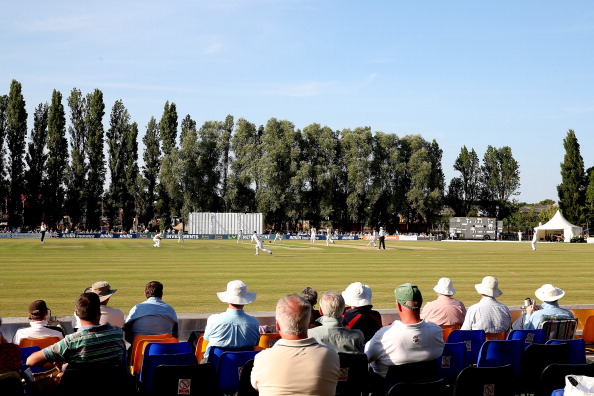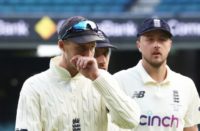Essex’s decision not to play cricket at Colchester next season looks like the further erosion of a tradition that goes back to the 19th century. For a game that sells itself as much on nostalgia as cutting edge modernity, cricket has an uncanny habit of yorking itself middle stump.
Castle Park in Colchester is the last outground used by Essex, following the decommissioning of Valentines Park in Ilford and Garon’s Park in Southend over the past 15 years. There used to be others, especially when the county ground was based at Leyton rather than Chelmsford. Then, Clacton, Romford and Brentwood all staged first-class cricket, their heyday but a distant memory as Health and Safety, relocation costs, as well as those of general upkeep, made cricket there impractical.
Yet Castle Park at Colchester remains a gem, especially when set up for Essex matches. With a river one end and overlooked by a 900-year old Norman castle, the largest surviving example in Europe, it possesses a bucolic charm entirely absent from modern cricket stadia. It is, literally, the grass roots, with many Essex players like Graham Napier and Neil Foster having learnt the game playing for the Colchester and East Essex Club based there.
Essex say that removing Castle Park is entirely due to a quirk in next season’s fixture list and that they have every intention of returning to play cricket there again in future. But like anything that requires that bit more effort and expense; once the bean counters see that you can cope without it, why go back?
I always enjoyed playing at Colchester, not least because it always seemed to provide exciting cricket. During my career, matches there have provided the best innings I have ever seen; an unbeaten double hundred by Javed Miandad; a record Sunday League score of 299, which was immediately beaten when Warwickshire chased it down; and a memorable Championship match against Glamorgan when I was run out by a brilliant piece of fielding by Matthew Maynard, attempting the winning run off the last ball of the match.
From purely selfish reasons, I enjoyed outgrounds, Essex’s as well as those of other counties. For one thing, they were never as manicured as many county grounds, while the pitches were rarely as well prepared as those at HQ, which usually meant there was a bit more in it for the bowlers. You never knew quite what to expect at outgrounds either, which made it a bit of a magical mystery tour for both players and spectators.
There could be extremes, such as the Championship match Essex played at Folkestone against Kent in 1980. On a pitch going through the top from the outset, the scores reflected the increasing difficulty of scoring runs on a wildly unpredictable surface. Essex won by 50 runs, their 130 and 76 over two innings being too good for Kent, who were dismissed for 88 and 68.
When asked by journalists afterwards why he thought Essex had prevailed, captain Keith Fletcher said: “It’s because we had better clouting louts than them,” a reference to the agricultural effectiveness of his own batting as well as that of the match’s top-scorer, Stuart Turner, who’d made 35 in Essex’s first innings.
Because cricketers play at outgrounds infrequently, the memories created there tend to stick. It was at Acklam Park in Middlesbrough, for instance, where I first met Geoffrey Boycott in 1978. Essex travelled there as a last resort when heavy rain had washed out all our attempts to play a Benson & Hedges match against Yorkshire in Harrogate.
But with rain also reducing that match to a 10-over slog, I was left out of the Essex side and Boycott was demoted to number seven by Yorkshire, their justification being that each ball was a scoring opportunity not a philosophical conundrum to be struggled with.
Essex lost by 26 runs. But as we were licking our wounds and packing up for our trip down the A1 home, in bounces Boycott to commiserate. “Bad luck lads, it’s a crap game when world’s best opening batsman has to drop down the order and doesn’t even get in.”
Well, as chance would have it, Mike Denness, Essex’s usual opener, had also been dropped down the order to accommodate the sloggers. Sensing there was some mischief to be had with his old England team-mate, Denness pipes up: “Why thank you Geoffrey, that is the nicest compliment you have ever paid me,” (the pair not being close).
To which Boycott replies, without a shred of self-awareness: “Not you numbskull, me.”
That Essex team were great at adapting, quickly, which is why we tended to do well at outgrounds. It was at Ilford and later Dean Park in Bournemouth that we twice won Championship matches after being made to follow-on. The second one, in 1992, had far-reaching effects. Before it, Hampshire had been in the top three of the table, but after that defeat they managed to win just one of their remaining 13 matches to finish 15th.
Of course, many of the outgrounds took players, especially those from Test playing counties, out of their comfort zone. Many was the time you would hear complaints about the splintery floors and tepid showers at Southend’s Southchurch Park, but that all played into the psychology of making opponents feel as uncomfortable as possible. Most visiting teams couldn’t wait to get out of there, and it was reflected in their cricket.
Outgrounds didn’t always play in our favour. A sub-standard pitch at Southchurch Park, for which Essex were docked the 25 points, cost us the 1989 Championship, Worcestershire pipping us by six points.
The punishment was scarcely deserved as there had been other pitches, home and away that season, which had been tougher to bat on. Yet word had got round that Essex were performing something akin to sorcery on their outgrounds, so easily were their opponents being dispatched. So, out came Donald Carr, the inquisitor general, to see for himself.
A few balls went through the top and misbehaved, certainly, but both Essex’s opponents in that festival week, Kent and Yorkshire, had won the toss and batted first. Yet, both had lost despite having the pick of the conditions, a point Carr did not seem to consider when handing down his penalty.
It was the only time an outground, rather than the players, had really let Essex down, something the club needs to remember when they remove cricket, for whatever reason, from places like Colchester.
This piece originally featured in The Cricket Paper, December 2 2016
Subscribe to the digital edition of The Cricket Paper here












